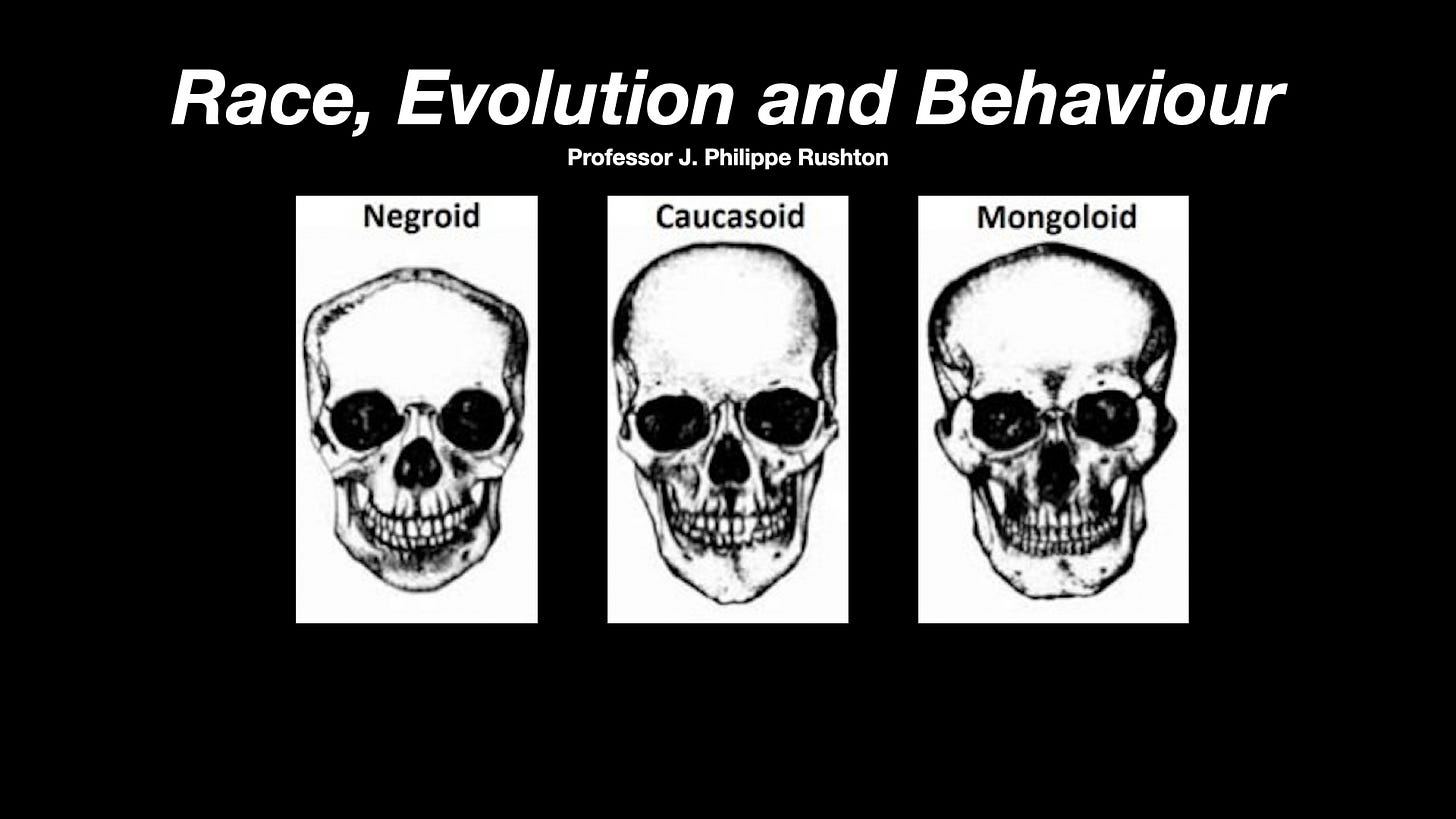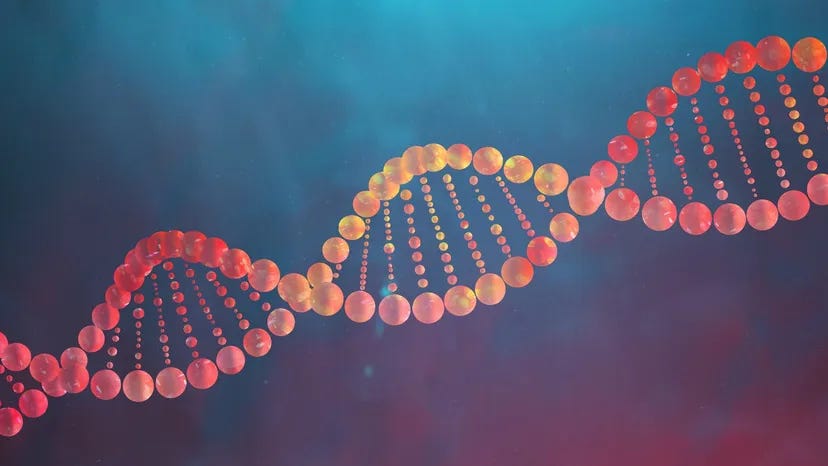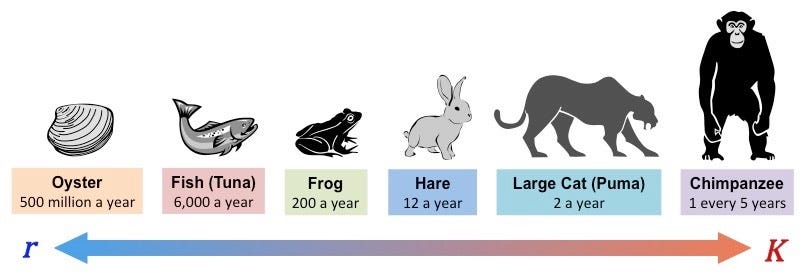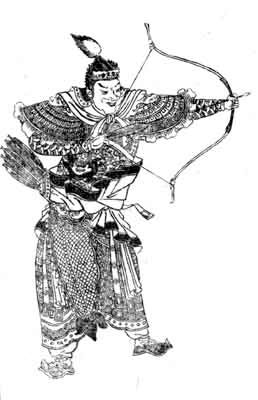N.B. All the words below are quotations, but I have edited the sequence for maximum clarity. This is the elephant in the room in discussions of critical race theory. CRT assumes all differences in racial outcomes are due to discrimination. But if the races differ in their aptitudes and interests, then equal opportunities will produce unequal outcomes. And this will be equitable.
A Summary of Professor J. Philippe Rushton’s Race, Evolution and Behaviour: A Life History Perspective
Fossil records, archaeology, and genetic DNA studies of the living races support Charles Darwin's insight that we evolved in Africa. Humans then spread to the Middle East, Europe, Asia, Australia, and then to the Americas. As humans left Africa, their bodies, brains and behaviour changed. True: all humans are brothers (and sisters). But we all know that brothers and sisters can still be very different from one another.
In both everyday life and evolutionary biology, a "Black" is anyone most of whose ancestors were born in sub-Saharan Africa, a "White" is anyone most of whose ancestors were born in Europe, and an "Oriental" is anyone most of whose ancestors were born in East Asia. Modern DNA studies give pretty much the same results.
The environment of Eurasia produced physical differences between the races. Northern Europe's cloudiness meant less sunshine. This decreased the intake of vitamin D, so lighter skin and hair were needed to let more sunlight get in. As a result, Europeans born with lighter skin and hair were healthier. They had more chance of having children who would survive and reproduce.
East Asia was even colder than North Europe, but with less cloud cover and more sunlight. There, a thicker layer of fat helped to insulate against the cold. This gives many Orientals a so-called "yellow" complexion because it reduces the visibility of red blood vessels close to the skin. Meanwhile in Africa melanin gives the skin a black colour to protect it from the scorching rays of the sun.
But race is more than "just skin deep.” Coroners in crime labs can identify race from a skeleton or even just the skull. They can identify race from blood, hair, or semen as well. The pattern of Oriental-White-Black differences is found across history, geographic boundaries, and political-economic systems.
Of course there are subdivisions within the three major races. The Oriental group can be subdivided into Northeast Asians (such as the Chinese, Japanese, and Koreans) and the Southeast Asians (such as the Filipinos and Malays). Black and White groups can also be subdivided in the same way.
Nevertheless, simplified three-way division serves a purpose. In science, a concept is useful if it groups facts so that general laws and conclusions can be drawn from them. The three-way classification is scientifically justified because it shows a consistent pattern for many different traits, with Orientals at one end, Blacks at the other, and Whites in between
r-K Life History Theory, a basic principle of modern evolutionary biology, explains the three-way pattern of differences in brain size, IQ, and behaviour. Every species of plant or animal can be placed on the r-K scale. The r end of the scale means having more offspring, maturing earlier, having smaller brains and providing less parental care. The K end of the scale means having fewer offspring, maturing later, having larger brains, and providing more parental care.
Humans are the most K species of all. Among humans, Orientals are the most K, Blacks the most r, and Whites fall in between. Africa is warmer than the northern continents, but it is a less stable habitat. Droughts, storms, and diseases from viruses, bacteria, and parasites cause high death rates, even today. Without modern medical care, insuring survival in Africa means having many young (r-strategy).
In the more stable environments of Europe and Asia, survival is insured from having fewer young, but caring for them very well (K-strategy). In Africa, food and warmth were available all year round. But to deal with the colder winters and scarcer food supply of Europe and Northeast Asia, the Oriental and White races moved away from an r-strategy toward the K-strategy. This meant more parenting and social organisation, which required a larger brain size and a higher IQ.
The three-way pattern of race differences is true for growth rates, life span, personality, family functioning, criminality, and success in social organisation. Black babies mature faster than White babies; Oriental babies mature slower than Whites. The same pattern is true for sexual maturity, out of wedlock births, and even child abuse. Around the world, Blacks have the highest crime rate; Orientals, the least; Whites, in between.
The same pattern is true for personality. Blacks are the most outgoing and even have the highest self-esteem. Orientals are the most willing to delay gratification. Whites fall in between. Blacks die earliest, Whites next, Orientals last, even when all have good medical care. The three-way racial pattern holds up from cradle to grave.
The three-way pattern of race differences is found in rates of multiple births (two-egg twinning), hormone levels, sexual attitudes, sexual anatomy, frequency of intercourse, and sexually transmitted diseases (STDs). Both male and female sex hormone levels are the highest in Blacks, the lowest in Orientals, with Whites in between. Sex hormones affect not only our bodies, but also the way we act and think.
Blacks are the most sexually active, have the most multiple births, and have the most permissive attitudes. Orientals are the least sexually active and show the least sexual fantasy and the most sexual guilt. Whites are in the middle. Sex diseases are most common in Blacks, least so in Orientals, with Whites in between the two. The very high rate of AIDS in Africa, the Black Caribbean and in Black Americans is alarming.
Studies of race differences in brain size use a number of methods, including MRI. All methods produce the same results. Orientals have the largest brains (on average), Blacks the smallest, and Whites in between. These differences in brain size are not due to body size. Adjusting for body size still results in the same pattern.
The reason why Whites and East Asians have wider hips than Blacks, and so make poorer runners is because they give birth to larger brained babies. During evolution, increasing cranial size meant women had to have a wider pelvis. East Asians run even less well than Whites. The same narrow hips, longer legs, more muscle, and more testosterone that give Blacks an advantage over Whites, give Whites an advantage over East Asians.
The three-way pattern is also true for IQ. These race differences in brain size mean that Orientals average about 102 million more brain cells than Whites, and that Whites have about 480 million more than Blacks. These differences in brain size probably explain the racial differences in IQ and cultural achievement.
In 1275 Marco Polo arrived in China from his native Italy to open trade with the Mongol Empire. He found that the Chinese had well built roads, bridges, cities connected by canals, census takers, markets, standardized weights and measures, and not only coins, but paper money as well. Even a postal system was in existence.
All of these made him marvel when he compared the Chinese to what he saw in Europe and the Middle East. Even though he was an Italian, proud of his people and well aware of the greatness of Ancient Rome, Marco Polo wrote: "Surely there is no more intelligent race on earth than the Chinese."
Historical research bears out Marco Polo's impressions. As early as 360 B.C., the Chinese used the cross bow and changed the face of warfare. Around 200-100 B.C., the Chinese used written exams to choose people for the civil service, two thousand years before Britain. The Chinese used printing about 800 A.D., some 600 years before Europe saw Gutenberg's first Bible.
Paper money was used in China in 1300, but not in Europe until the 19th and 20th centuries. By 1050 Chinese chemists had made gunpowder, hand grenades, fire arrows, and rockets of oil and poison gas. By 1100, factories in China with 40,000 workers were making rockets. Flame throwers, guns, and cannons were used in China by the 13th century, about 100 years before Europe.
The Chinese used the magnetic compass as early as the 1st century. It is not found in European records until 1190. In 1422, seventy years before Columbus's three small ships crossed the Atlantic, the Chinese reached the east coast of Africa. They came in a great fleet of 65 ocean going ships filled with 27,000 soldiers and their horses, and a year's supply of grain, meat, and wine.
Genes play a big part in personality, attitudes, and other behaviours. This is true for Orientals, Whites, and Blacks. Trans-racial adoption studies (where infants of one race are adopted and reared by parents of a different race), studies of regression to the mean (which compare parents and siblings in the different racial groups), and of inbreeding depression (which study the children of closely-related parents) all provide evidence for why genes cause the races to differ in IQ and personality. No purely cultural theory can explain these results, which are not only explained but predicted by genetic theory.
There is a lot of variation within each of the three races. The full range of variation will be found within any of the major racial groups. Still, group averages are important. Each racial group has a bell curve distribution with some people at the high end and some at the low end, and most people in the middle.
Hereditarians think the best explanation of why the races differ involves both genes and environment. Egalitarians claim the races differ for 100% cultural reasons and some of them feel so strongly about it that they try to stop even discussion or research on the genetics of race. They fear any open discussion of race research, all of which has appeared in peer-reviewed scientific journals.
Truth, however, always wins out in the long run. When we look at both genes and environment we may be able to understand human problems. With that knowledge, society can then go about trying to solve them. The first step is for all of us to be as honest as we can be about race, evolution, and behaviour.
Further Reading
https://archive.org/details/RaceEvolutionAndBehaviorALifeHistoryPerspective2ndSpecialAbridgedEditionJ.PhilippeRushton
https://archive.org/details/J.PhilippeRushtonRaceEvolutionAndBehaviobOk.xyz
https://www1.udel.edu/educ/gottfredson/30years/Rushton-Jensen30years.pdf
https://www.mdpi.com/2624-8611/1/1/9/htm
https://philipperushton.net/wp-content/uploads/2015/02/Race-and-IQ-A-Theory-Based-Review-of-the-Research-in-Richard-Nisbett’s-Intelligence-and-How-to-Get-It-2010-by-John-Philippe-Rushton-Arthur-Robert-Jensen.pdf
https://quillette.com/2019/06/05/superior-the-return-of-race-science-a-review/
https://time.com/91081/what-science-says-about-race-and-genetics/
Entine, J. (2000). Taboo: Why Black Athletes Dominate Sports and Why We Are Afraid to Talk About It. New York: Public Affairs Press.
Lewis, B. (1990). Race and Slavery in the Middle East. New York: Oxford University Press. Rushton, J. P. (1997).
Cranial size and IQ in Asian Americans from birth to age seven. Intelligence, 25(1), 7–20. https://doi.org/10.1016/S0160-2896(97)90004-0
Herman-Giddens, M. E., and others. (1997). Secondary sexual characteristics and menses in young girls seen in the office practice.
Pediatrics, 99, 505-512. https://doi.org/10.1542/peds.99.4.505
Rushton, J. P. (1995). Race and crime: International data for 1989–1990. Psychological Reports, 76(1), 307–312. https://doi.org/10.2466/pr0.1995.76.1.307
Ellis, L., & Nyborg, H. (1992). Racial/ethnic variations in male testosterone levels: A probable contributor to group differences in health. Steroids, 57, 72-75. https://doi.org/10.1016/0039-128X(92)90032-5
Jensen, A. R. (1998). The g Factor. Westport, CT: Praeger. Weinberg, R. A., Scarr, S., & Waldman, I. D. (1992).
The Minnesota Transracial Adoption Study: A follow-up of IQ test performance at adolescence. Intelligence, 16(1), 117–135. https://doi.org/10.1016/0160-2896(92)90028-P
Johanson, D. C. & Edey, M. A. (1981). Lucy: The Beginnings of Humankind. New York: Simon & Schuster.
Lovejoy, CO. (1981). The origin of man. Science, 211, 341-350. https://doi.org/10.1126/science.211.4480.341
Cavalli-Sforza, L. L., Menozzi, P., & Piazza, A. (1994). The History and Geography of Human Genes, Princeton, NJ: Princeton University Press.
Stringer, C. & McKie, R. (1996). African Exodus. London: Cape.
Levin, M. (1997). Why Race Matters. New York: Praeger. Rushton, J. P. (2000).




















Share this post